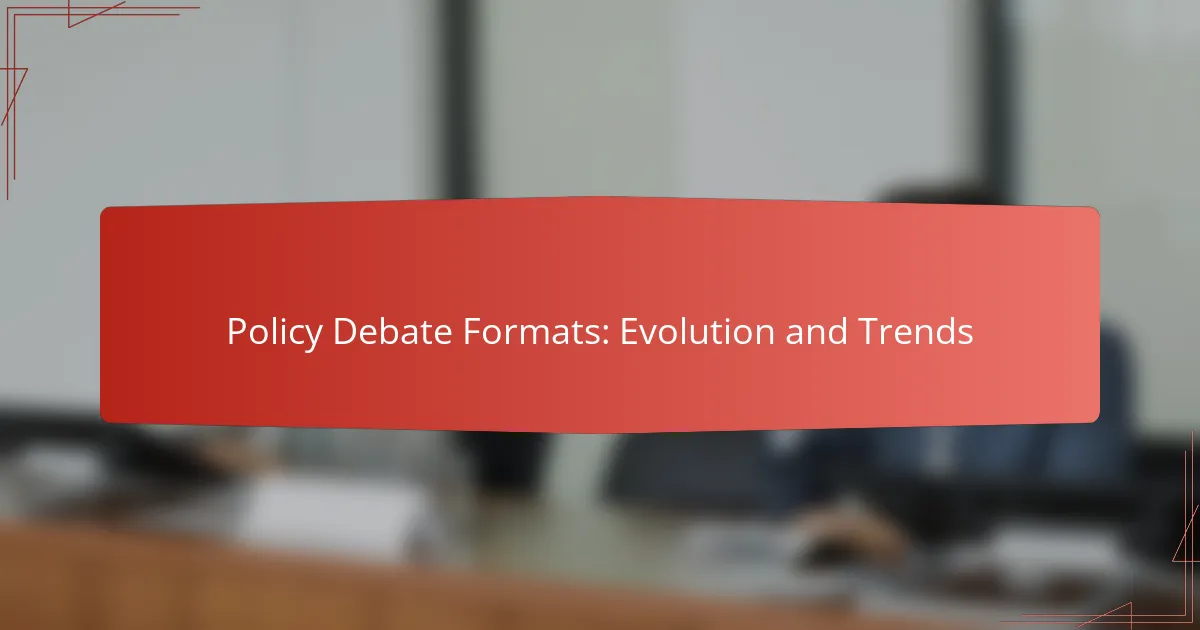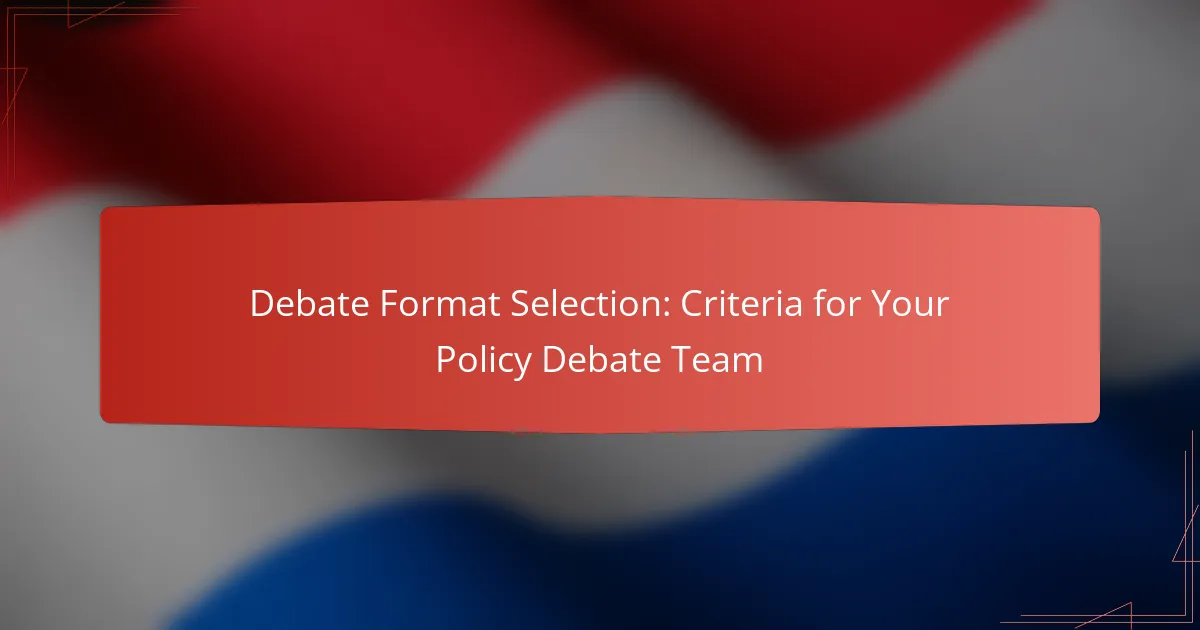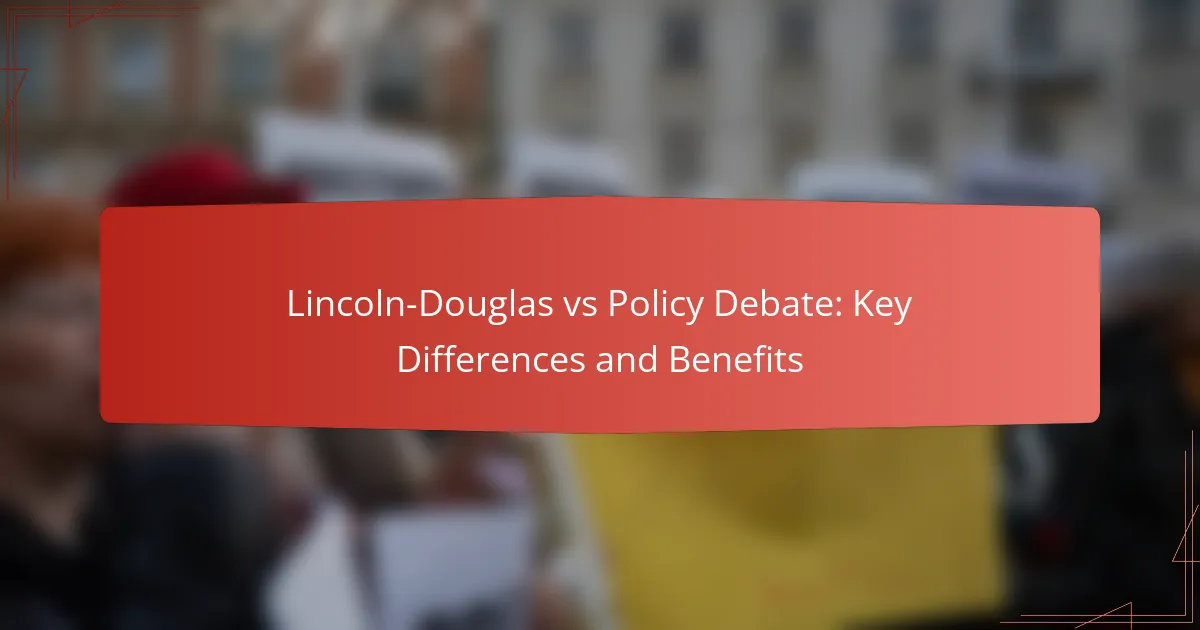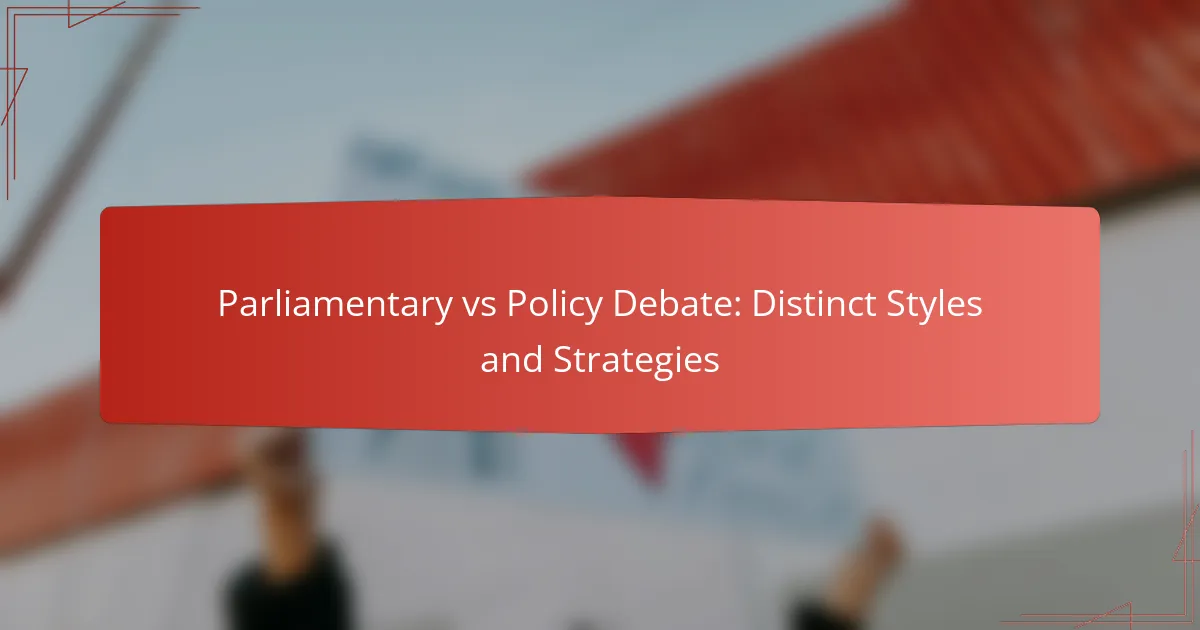Policy debate formats have evolved significantly over time, adapting to the changing educational landscape and societal trends. Current formats emphasize various aspects of argumentation, audience engagement, and structure, catering to diverse preferences and objectives. As digital engagement and inclusivity become increasingly important, these trends reflect a commitment to fostering critical thinking and effective communication among participants.
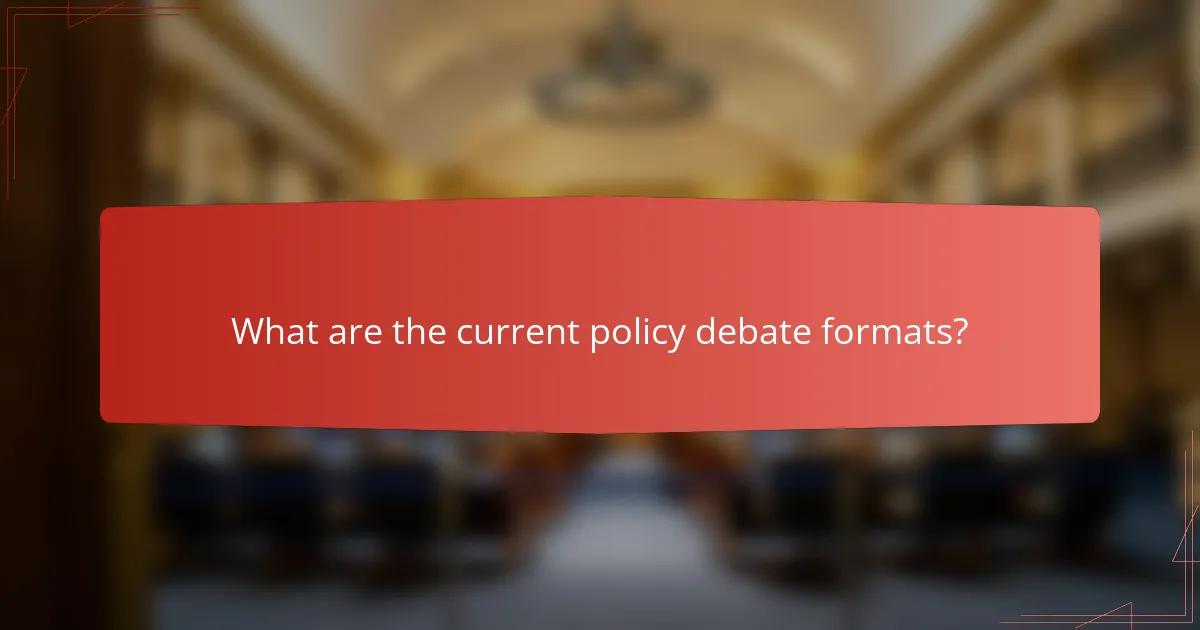
What are the current policy debate formats?
Current policy debate formats include various styles that emphasize different aspects of argumentation, audience engagement, and structure. Each format has unique rules and focuses, catering to diverse debating preferences and educational objectives.
Lincoln-Douglas Debate
Lincoln-Douglas debate centers on values and ethics, typically involving two participants who argue a resolution that often reflects moral dilemmas. This format emphasizes critical thinking and philosophical reasoning, with debaters required to construct arguments and rebuttals based on ethical principles.
Debaters prepare for a range of topics, often related to social issues or political philosophy. A common structure includes a 13-minute affirmative speech, a 13-minute negative speech, and a series of rebuttals, allowing for in-depth exploration of the resolution.
Public Forum Debate
Public Forum debate is designed to engage a general audience, focusing on current events and public policy issues. It features teams of two, with each side presenting arguments for and against a resolution that is typically accessible and relevant to everyday citizens.
This format encourages clarity and persuasion, with a structure that includes constructive speeches, rebuttals, and summary speeches. Debaters should aim to use clear language and relatable examples to effectively communicate their points to a non-specialist audience.
Policy Debate
Policy debate involves two teams of two that advocate for and against a specific policy proposal, often related to government action. This format is characterized by extensive research and evidence, requiring debaters to present detailed plans and counterplans.
Debaters engage in a structured format that typically includes a series of constructive speeches, rebuttals, and cross-examinations. Success in policy debate hinges on the ability to provide substantial evidence and effectively refute opponents’ arguments.
World Schools Debate
World Schools debate combines elements of both prepared and impromptu debating, featuring teams of three to five members. This format allows for a mix of pre-prepared topics and on-the-spot resolutions, fostering adaptability and teamwork among participants.
Debaters are expected to present arguments in a structured format that includes constructive speeches and rebuttals. The emphasis is on developing a coherent argument while also being able to think quickly and respond to unexpected topics.
Parliamentary Debate
Parliamentary debate mimics the style of parliamentary procedure, with teams of two debating a motion that is announced shortly before the debate begins. This format encourages spontaneity and quick thinking, as debaters must prepare arguments on the fly.
Each debate consists of speeches from both sides, with a focus on persuasive rhetoric and logical reasoning. Debaters should be familiar with parliamentary rules and practice effective communication to engage the audience and judges effectively.
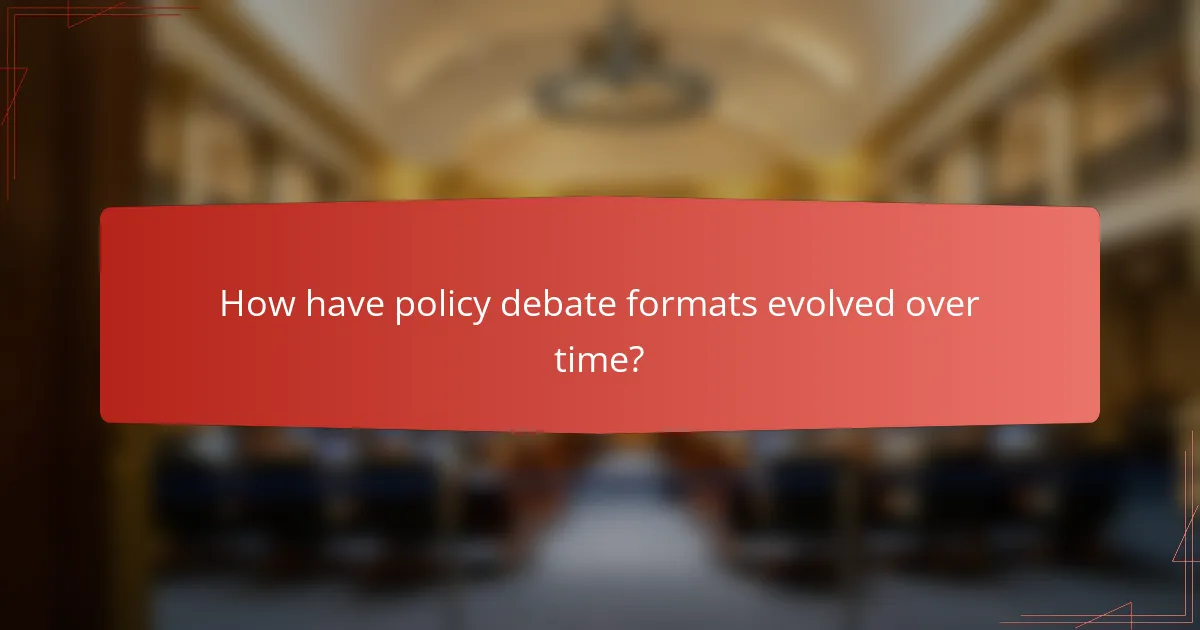
How have policy debate formats evolved over time?
Policy debate formats have undergone significant changes, adapting to educational needs and societal trends. These transformations reflect shifts in argumentation styles, participant engagement, and the integration of technology.
Historical Development
The roots of policy debate can be traced back to the early 20th century, where it primarily focused on public policy issues. Initially, debates were structured around formal rules and limited preparation time, emphasizing logical reasoning and rhetoric. Over the decades, formats evolved to include more extensive research and preparation, allowing debaters to explore complex topics in greater depth.
By the late 20th century, the introduction of national tournaments and standardized formats led to a more uniform approach across schools and regions. This standardization helped foster a competitive environment, encouraging students to refine their skills and strategies.
Key Milestones
Several key milestones have marked the evolution of policy debate formats. The establishment of the National Forensic League in the 1920s provided a framework for competitive debate, while the introduction of the Cross-Examination Debate Association in the 1980s emphasized a more interactive format. These organizations helped shape the rules and guidelines that govern contemporary policy debates.
In recent years, the rise of online debate platforms has further transformed the landscape, allowing for remote participation and access to a broader audience. This shift has made policy debate more inclusive, enabling students from various backgrounds to engage in the activity.
Influence of Technology
Technology has played a crucial role in the evolution of policy debate formats, particularly with the advent of digital research tools and online resources. Debaters now have access to vast databases of information, enabling them to construct more informed arguments and counterarguments. This access has shifted the focus from memorization to critical thinking and analysis.
Moreover, the use of video conferencing tools has facilitated virtual debates, allowing participants to connect regardless of geographical barriers. This trend has expanded opportunities for collaboration and competition, making policy debate more accessible to students worldwide.
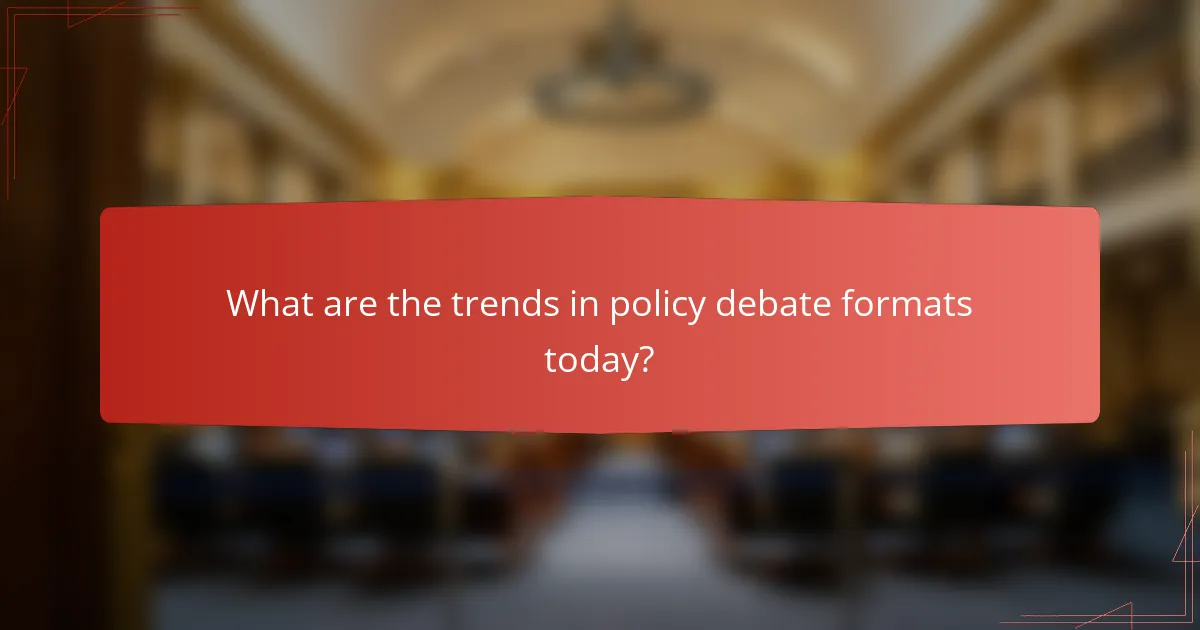
What are the trends in policy debate formats today?
Current trends in policy debate formats emphasize digital engagement, inclusivity, and critical thinking. These shifts reflect the evolving landscape of communication and education, adapting to the needs of diverse participants and the demands of contemporary discourse.
Increased Use of Digital Platforms
Digital platforms have become integral to policy debate formats, allowing participants to engage remotely and access a wider audience. Tools like Zoom, Google Meet, and specialized debate software facilitate real-time discussions and enable asynchronous participation, making debates more accessible.
Debate organizations are increasingly hosting competitions online, which can reduce costs associated with travel and venue rental. However, participants must be aware of potential technical issues and ensure they have reliable internet connections to avoid disruptions.
Focus on Inclusivity
Inclusivity in policy debate formats aims to create a welcoming environment for participants from various backgrounds. This trend includes providing resources and support for underrepresented groups, ensuring diverse perspectives are included in discussions.
Debate organizations are implementing training programs and mentorship opportunities to help newcomers adapt to the competitive landscape. Additionally, using gender-neutral language and accommodating different learning styles can enhance participation and engagement.
Emphasis on Critical Thinking
There is a growing emphasis on critical thinking skills within policy debate formats, encouraging participants to analyze arguments deeply and develop well-reasoned positions. This focus helps debaters not only in competitions but also in real-world applications of their skills.
Judges are increasingly looking for nuanced arguments and the ability to engage with opposing viewpoints effectively. Debaters should practice constructing counterarguments and utilizing evidence to support their claims, fostering a more robust debate environment.

What factors influence the choice of debate formats?
The choice of debate formats is influenced by various factors including audience engagement, educational objectives, and judging criteria. Each of these elements plays a crucial role in determining how debates are structured and conducted, impacting the overall effectiveness and experience for participants and spectators alike.
Audience Engagement
Audience engagement is vital in selecting a debate format, as it determines how well the audience can connect with the topics and speakers. Formats that encourage interaction, such as town hall debates or panel discussions, tend to foster greater participation and interest.
Consider the demographic of the audience when choosing a format. For example, younger audiences may respond better to dynamic formats like Lincoln-Douglas debates, while more traditional settings may suit older or professional audiences. Engaging the audience can also involve using technology, like live polls or Q&A sessions, to enhance interaction.
Educational Objectives
Educational objectives significantly shape the choice of debate formats, as different formats serve various learning goals. For instance, formats that emphasize critical thinking and argumentation skills, such as policy debates, are often used in academic settings to prepare students for real-world discussions.
When selecting a format, consider the specific skills you want participants to develop. If the goal is to enhance public speaking abilities, formats that allow for extensive rebuttals and cross-examinations may be more beneficial. Aligning the format with educational goals ensures that participants gain the intended knowledge and experience.
Judging Criteria
Judging criteria are essential in determining the appropriate debate format, as they dictate how arguments will be evaluated. Different formats may prioritize various aspects, such as the quality of evidence, delivery style, or the ability to counter opposing arguments.
When establishing judging criteria, clarity is key. Ensure that judges understand what is being assessed, whether it’s logical reasoning, persuasive techniques, or adherence to time limits. Formats like parliamentary debates often have specific rules that influence judging, so it’s crucial to align the format with the established criteria for fair evaluation.
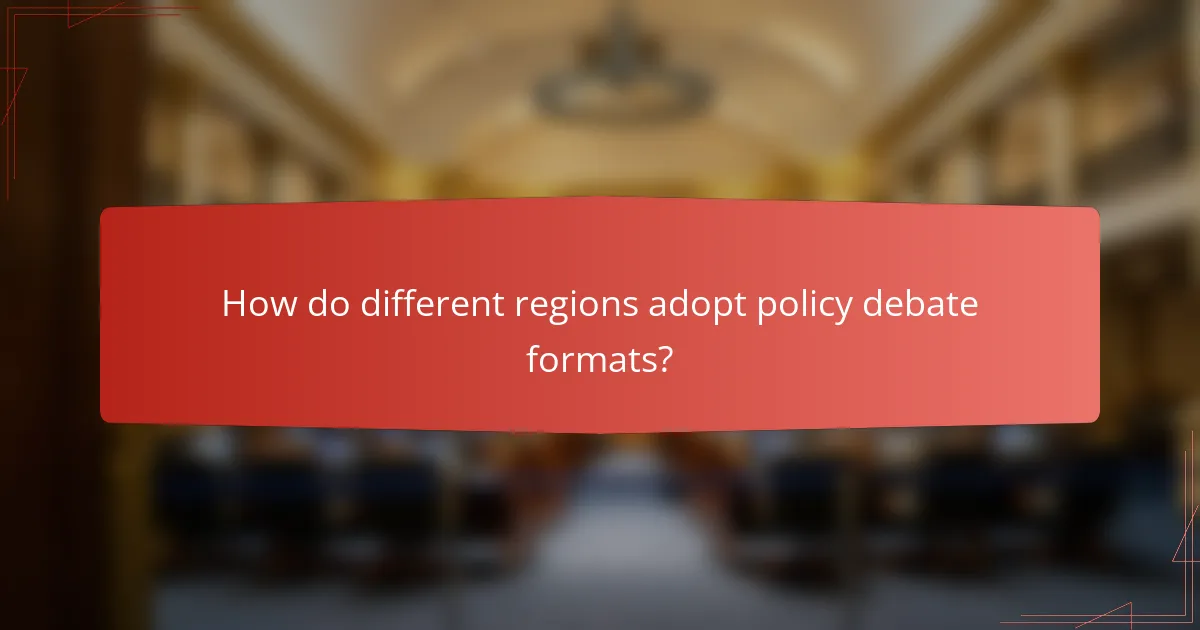
How do different regions adopt policy debate formats?
Regions adopt policy debate formats based on cultural, educational, and competitive preferences, leading to distinct practices and structures. These variations reflect local values and the objectives of debate as an educational tool.
North American Practices
In North America, particularly the United States and Canada, policy debate often emphasizes a format where teams advocate for or against a specific policy resolution. The debates typically involve extensive research and preparation, with rounds lasting around 45 minutes, including preparation time.
Competitions are structured with multiple elimination rounds, culminating in national championships. The National Speech and Debate Association (NSDA) and the National Forensic League (NFL) set guidelines that many schools follow, ensuring a standardized approach to judging and scoring.
European Variations
European policy debate formats can vary significantly by country, with some regions adopting a more parliamentary style. For instance, in the UK, the British Parliamentary format is popular, where teams of two debate against each other in a more fluid, less structured environment.
Debates often focus on broader societal issues rather than specific policy proposals, allowing for a wider range of arguments. While the timing can differ, debates typically last around 15-20 minutes per speaker, promoting quick thinking and adaptability among participants.
